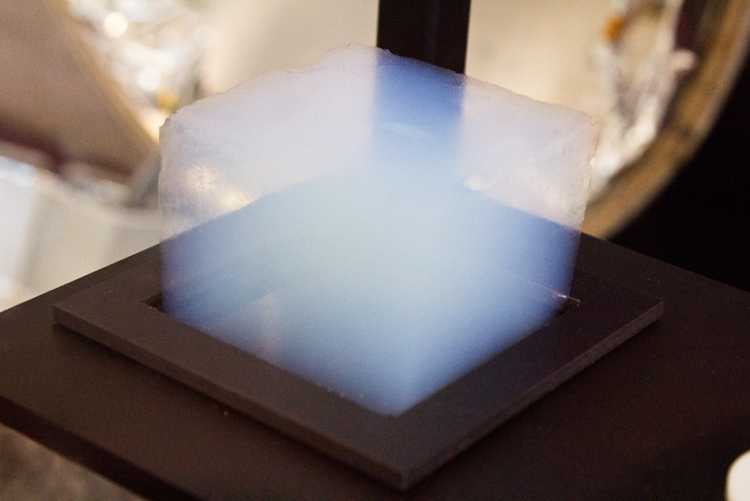

SEARCH
Aerogels are a class of low-density solid gels in which the liquid is replaced by air or gas. Currently, the aerogels we commonly use are usually based on silica, but other materials can also be used, including carbon, metal oxides, graphene and so on.

The pore size of aerogel is on the nanoscale and it has a porous, spongy structure. This gives the aerogel an unusually large surface area. Aerogel is made up of 99.8% air and has an extremely low density and mass. Aerogel is hydrophilic (affinity for water) because its structure is covered by an -OH(hydroxyl) group. In fact, aerogel can hold up to 25 times its own weight in water. However, exposing the aerogel to water can cause the material to permanently lose its structural integrity. Aerogel has low thermal conductivity. The mean free path of air molecules through is greater than the width of the aerogel hole, making it difficult for heat to transfer through the material.
The aerogel appears light blue because the aerogel scatters shorter wavelengths (such as blue) in the visible spectrum, rather than longer wavelengths (such as red or orange), giving the aerogel its distinctive blue hue. Under ultraviolet light, the aerogel appears opaque, while under infrared light, the aerogel appears transparent.
It is important to note that aerogel is a hard, rigid material and therefore difficult to work with. At the same time, aerogels are also brittle, and falling from even the smallest height can cause the material to break.
The disadvantages of aerogel can be mitigated by combining with other materials to form aerogel insulation. For example, aerogel is combined with materials such as reinforced fibers to make aerogel thermal MATS, making them flexible and easy to use. In addition, aerogels can bind to reactive hydrophobics to reverse their hydrophilic properties.
First, aerogel insulation felt has the following advantages:
1, high temperature: Due to the high porosity and low density characteristics of aerogel, aerogel insulation material has excellent thermal performance, better than wool and glass fiber.
2, thinner insulation felt: Thinner aerogel insulation felt can provide the same thermal performance as other types of thicker insulation. This makes installation and disassembly easier for maintenance and repair personnel, thus reducing the time spent.
3, sub-zero temperature insulation: Even in harsh, cold conditions, aerogel insulation remains flexible, making it easier for personnel to perform maintenance and repair tasks.
4, waterproof: The combination of reactive hydrophobic compounds with aerogel can reverse its natural hydrophilic properties, so that it can cope with high humidity conditions.
Second, the application range of aerogel insulation felt
Aerogel insulation felt used to be used only in aerospace, but now it has become an increasingly desirable material as an industrial, building insulation material for a variety of applications:
1, limited space: The thin shape of aerogel insulation felt makes it an ideal material for compact environments with limited space.
2, delicate and/or fragile parts: The lightweight nature of aerogel insulation felt allows it to fit tightly around delicate or fragile parts.
3, humid environment: Aerogel insulation felt due to its hydrophobic properties, can cope with high humidity or Marine applications, making it suitable for protecting components from water and corrosion.
4, high temperature environment: the general aerogel insulation felt can withstand the high temperature of 650 ° C, and the aerogel specifically for the high temperature field can withstand the high temperature of 2000 ° C, which can greatly increase the safety performance.
Aerogel insulation mat is a very popular insulating material, and its appearance makes impossible solutions feasible.
Related